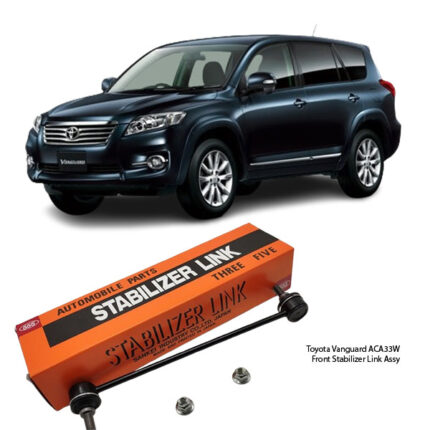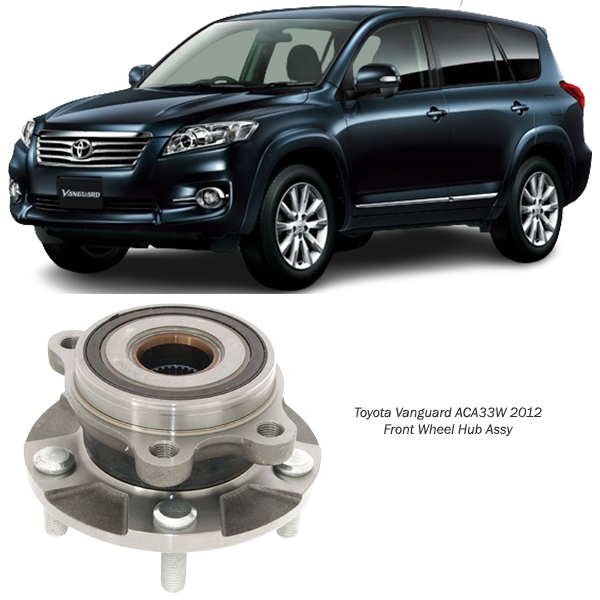Get Toyota Vanguard ACA33W 2012 Front Wheel Hub Assy 43550-42020 in Kenya
Hub Bearings: The Silent Supporters of Vehicle Stability and Smooth Movement
In the complex machinery that propels our vehicles, hub bearings stand out as essential components that often work silently behind the scenes. These unassuming but crucial elements play a pivotal role in ensuring the smooth rotation of wheels, contributing to vehicle stability, safety, and overall performance. This exploration aims to unravel the significance of hub bearings, delving into their functions, types, potential issues, and the impact they have on the driving experience.
Understanding Hub Bearings:
Hub bearings, also known as wheel bearings, are essential elements in a vehicle’s wheel assembly. They facilitate the rotation of the wheel by reducing friction between the wheel hub and the spindle or axle. Hub bearings are mounted within the hub assembly and are positioned at the center of the wheel, allowing it to spin freely.
Functions of Hub Bearings:
- Smooth Wheel Rotation: The primary function of hub bearings is to enable smooth and frictionless rotation of the wheels. This is crucial for efficient vehicle movement and optimal fuel efficiency.
- Load Bearing: Hub bearings bear the vertical and lateral loads exerted on the wheels, providing support to the vehicle’s weight and handling forces during turns and maneuvers.
- Reducing Friction: By incorporating rolling elements, typically balls or rollers, hub bearings reduce the friction between the wheel hub and the axle. This design minimizes wear, heat generation, and energy loss, contributing to the overall efficiency of the vehicle.
- Sealing and Protection: Many hub bearings are equipped with seals to protect against contaminants such as dirt, water, and debris. This sealing mechanism extends the lifespan of the bearings by preventing premature wear and damage.
Types of Hub Bearings:
- Ball Bearings: Ball bearings are the most common type of hub bearings and consist of small, metal balls that enable smooth rotation. They are known for their durability and ability to handle both radial and axial loads.
- Tapered Roller Bearings: Tapered roller bearings use conical rollers to support both radial and axial loads. They are often found in heavy-duty applications due to their robust design and load-carrying capabilities.
- Angular Contact Bearings: Angular contact bearings are designed to handle combined radial and axial loads. They have contact angles that allow them to withstand both types of forces, making them suitable for applications with varying load conditions.
Importance of Hub Bearings:
- Vehicle Stability: Hub bearings play a crucial role in maintaining the stability and control of the vehicle. Properly functioning hub bearings contribute to a smooth and controlled ride, especially during turns and maneuvers.
- Efficient Fuel Economy: The reduced friction achieved by hub bearings contributes to improved fuel efficiency. By minimizing resistance in the wheel assembly, the engine has to work less, translating to better mileage.
- Safety Assurance: Hub bearings directly impact the safety of a vehicle. Any failure or malfunction can lead to issues such as uneven tire wear, vibrations, and compromised handling, posing safety risks. Regular maintenance and prompt replacement of worn bearings are essential for ensuring a safe driving experience.
- Enhanced Comfort: Well-maintained hub bearings contribute to a comfortable ride by allowing the wheels to rotate smoothly. This reduces vibrations and harshness, providing a more pleasant experience for occupants.
Common Issues and Maintenance:
While hub bearings are designed for durability, they can still experience wear and issues over time. Common problems include:
- Noises: A common sign of worn hub bearings is unusual noises, such as grinding, humming, or roaring sounds emanating from the wheel assembly. These noises are typically more pronounced during turns and can indicate the need for replacement.
- Vibrations: Worn hub bearings can lead to vibrations in the steering wheel or the vehicle itself. These vibrations can affect the overall driving experience and indicate the need for inspection and potential replacement.
- Uneven Tire Wear: Improperly functioning hub bearings can result in uneven tire wear. Monitoring the condition of the tires and addressing irregular wear patterns can help identify potential issues with the hub bearings.
- Play or Looseness: Excessive play or looseness in the wheel assembly can be a sign of worn or damaged hub bearings. This can compromise vehicle stability and handling.
Conclusion:
In the grand orchestration of vehicular movement, hub bearings emerge as silent heroes, supporting the wheels and contributing to the overall performance and safety of a vehicle. Their role in facilitating smooth wheel rotation, bearing loads, and reducing friction underscores their importance in the intricate machinery of an automobile. Recognizing the significance of hub bearings emphasizes the need for regular maintenance, inspections, and timely replacements to ensure the continued reliability and efficiency of a vehicle. These unassuming components, tucked away within the wheel assembly, embody the precision and engineering excellence that define a safe and enjoyable driving experience.




